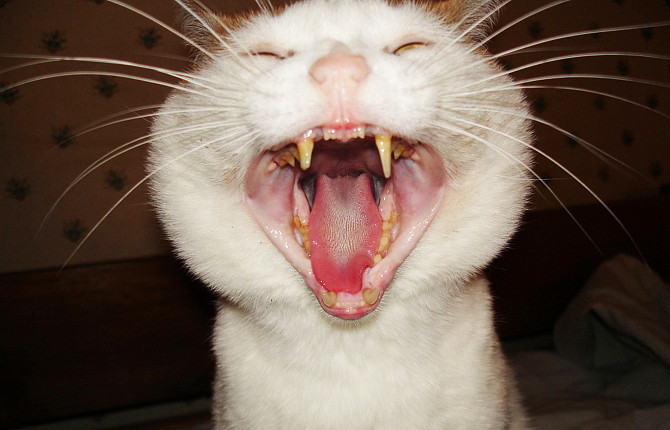What Is Feline Stomatitis?
Gingivitis is an inflammation of the mucous membrane of the cat's gums.
Stomatitis is an inflammation of the entire oral mucosa, affecting the posterior pharyngeal wall and the area of the upper and lower jaw.
Video About Feline Stomatitis
Classification of Stomatitis in Cats
Feline stomatitis is dangerous because it has multiple forms and types that differ in clinical presentation, causes, and treatment methods. The following types of stomatitis in cats are distinguished:
1. By disease progression
✅ Acute✅ Chronic
2. Based on the causes of the disease
✅ Primary – develops as a result of chemical, mechanical, or thermal damage to the mucous membrane.
✅ Secondary – caused by other diseases, such as viral and fungal infections, endocrine disorders, or autoimmune diseases.
3. By type of inflammatory process
✅ Catarrhal stomatitis – characterized by redness, swelling, gum pain, excessive salivation, plaque, and bad breath. Often caused by dental calculus and cavities. It is the initial form that can progress if untreated.
✅ Ulcerative stomatitis – formation of ulcers on the mucous membranes, with varying depth and size. Often accompanied by fever. If untreated, necrosis may develop.
✅ Gangrenous stomatitis – a complication of ulcerative or phlegmonous stomatitis, leading to tissue necrosis and a strong putrid odor. Requires surgical treatment.
✅ Uremic stomatitis – a secondary form due to chronic kidney failure, where toxic substances accumulate in the blood. Diagnosed via blood tests.
✅ Autoimmune (lymphocytic) stomatitis – immune-mediated inflammation of the gums and tooth roots, often requiring tooth extraction.
✅ Lymphoplasmacytic (caudal) stomatitis – a chronic condition affecting the oral cavity and the caudal part of the pharynx, considered idiopathic.
✅ Eosinophilic stomatitis – suspected allergic origin, characterized by firm, painless ulcers on the upper lip.
✅ Infectious stomatitis – caused by bacterial, viral, or fungal infections (e.g., Candida or pyogenic bacteria).
✅ Viral stomatitis – secondary to immune deficiency, commonly associated with calicivirus, panleukopenia, or feline herpesvirus.
✅ Papillomatous stomatitis – characterized by cauliflower-like growths on the mucosa, caused by papillomavirus infection.
✅ Phlegmonous stomatitis – accumulation of pus under the mucosa, increasing the risk of sepsis and requiring thorough debridement.
4. Classification of Stomatitis by Location
Stomatitis is classified based on its location as follows:
✅ Glossitis – localized on the tongue.
✅ Faucitis and palatinitis – characterized by inflammation of the palate and lingual arch.
✅ Gingivitis – affects the gums.
✅ Cheilitis – affects the cat’s lips.
✅ Gingivostomatitis – involves inflammation of the entire oral cavity.
5. By localization of lesions
✅ Focal
✅ Diffuse
Stomatitis in cats requires professional veterinary care for proper diagnosis and treatment.
Despite the differences in forms, the symptoms of stomatitis are usually the same.
Symptoms of Stomatitis in Cats
When a cat develops stomatitis and inflammation in the mouth, its behavior changes. The cat becomes more nervous, refuses food and even favorite treats, drinks water frequently, and washes its face more often.
In addition, other symptoms may appear:
-
Excessive drooling
-
Decreased appetite
-
Enlarged lymph nodes under the jaw
-
Pinkish saliva
-
Bad breath
-
Lethargy
-
Ulcers in the mouth and on the lips
These are general signs characteristic of various forms of stomatitis and indicate the need for veterinary attention.
